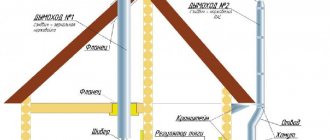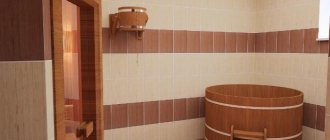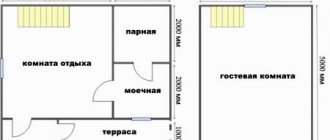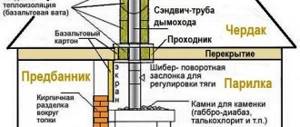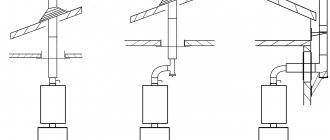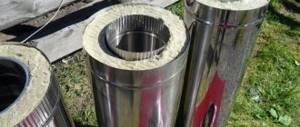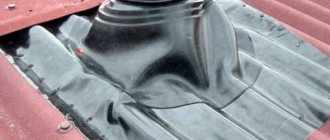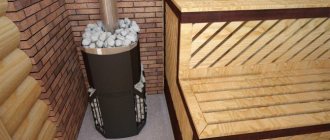Types of clogs and the need for cleaning
The need to clean the chimney arises due to improper operating conditions of the stove. Some of them can be prevented at an early stage, and some are eliminated only as they appear.
The most common causes of blockages in pipes include:
- condensation accumulation;
- soot formation;
- ash accumulation;
- foreign objects entering the chimney.
Soot formation
If the pipe in the attic is not insulated, drops of moisture form on its surface. They absorb combustion products produced by firewood, forming soot. With each use of the stove, this layer gradually thickens until the pipe is almost completely overgrown.
Condensation accumulation
When using wet wood to light a stove, a large amount of steam is generated. It accelerates the process of overgrowing the chimney with soot, blocking the draft. Try to keep wood in a dry, ventilated place.
Foreign objects getting inside
If the chimney opening is wide enough and not covered with a protective cap, various foreign objects can get into it. Initially, they do not have a significant effect on the operation of the furnace, but as they accumulate, the draft begins to get worse and worse.
Resin deposition
Many bathhouse owners do not suspect that the material of wood used to fire the stove directly affects the rate at which the pipe becomes clogged. When softwood is used for kindling, a large amount of resin evaporates into the air, some of which settles on the walls of the chimney. It is prohibited to place objects made of plastic, chipboard and plywood sheets into the firebox.
Note! Experienced bathhouse owners advise using wood made from hardwood for ignition.
Ash accumulation
Chimneys made with a large number of bends become clogged with ash faster than usual. When designing a chimney, try to choose a simple design with a minimum number of elbows. If the situation forces you to use complex, bent structures, install special hatches near the bends, through which it will be convenient to clean out ash and other debris in the future.
Causes of a clogged chimney in a bathhouse
A clogged pipe can happen for a variety of reasons. The accumulation of soot on the inner surface of the chimney pipe described above is an inevitable process, because fuel combustion products in the form of particles themselves settle on a metal or brick surface.
The process of plaque formation is accelerated by condensation from water vapor, which is formed from moisture in the wood fibers.
When using firewood from coniferous trees, which produce acidic sediment, the formation of plaque on the pipe occurs even faster.
Other reasons for a clogged chimney are a mechanical obstacle that blocks the lumen of the pipe. This could be a nest or a bird accidentally falling into the chimney, a tree branch, a piece of roofing material or other objects.
It is important! Mechanical clogging is a dangerous phenomenon: it not only reduces, but completely eliminates draft, and using the firebox becomes dangerous. Exhaust gases and combustion products will flow back into the room and poison the air.
How to check the status
If the oven begins to function intermittently, it is necessary to determine the cause of the malfunction. For this use:
- visual inspection;
- special video systems;
- are guided by indirect signs that indicate a clogged chimney.
See also
TOP 25 remedies on how and how to clean leather shoes at home
Visual inspection
The most affordable method that does not require owners to have certain tools or skills. Enough:
- remove the pipe;
- check its insides for blockages.
Special video systems
If you don’t have the strength or desire to dismantle the chimney, use special video systems. They are placed inside the chimney and inspect it for blockages along its entire length. This option requires significant financial costs, but you will know the current condition of the furnace with 100% accuracy.
Indirect signs
If you don’t have money for a video system, focus on indirect signs that appear when problems occur with the pipe. These include:
- penetration of smoke into the room during ignition;
- firewood burns slowly;
- flakes of soot fly in the air;
- during operation, the stove emits unpleasant odors;
- the fire goes out randomly.
Slow kindling
Due to poor ventilation inside the chamber, smoke quickly fills its entire volume, and the firewood burns more slowly than usual. If this happens to your stove, it's time to think about cleaning it. There is no point in delaying this, since the chimney is already in critical condition and will soon fail completely.
Smoke comes in
In the event that smoke begins to penetrate through the damper in the stove, ignition must be stopped, and the chimney must be cleaned as soon as possible. In this case, the situation is extremely deplorable, since the chimney opening is completely clogged with combustion products.
Poor traction
Pay attention to the color of the fire in the firebox while the stove is operating. With good draft, the flames are directed upward and have a bright color. If the flame is dim and the reeds constantly fluctuate, it means that the draft is not sufficient, and the pipe needs preventive cleaning.
Black smoke
Black smoke escaping from the chimney indicates:
- poor quality firewood;
- pipe clogging.
You should either clean the pipe or select other firewood for ignition.
Soot flakes
Soot flakes flying in the air during kindling indicate severe clogging of the pipe. If this is not corrected, the chimney will become completely overgrown with soot, making it much more difficult to clean.
Arbitrary flame extinction
There are often cases when the flame in the firebox suddenly goes out. This occurs due to a lack of oxygen in the firebox, since the draft is minimal or completely absent. It is not worth continuing to use such a stove, as nothing good will come of it.
Unpleasant odor during heating
The cause of the unpleasant odor is carbon monoxide. It is not removed through a clogged chimney, but goes indoors. If such a situation occurs, you should immediately stop ignition and ventilate the room.
Video description
How vacuum cleaning of chimneys occurs is shown in the video:
Having completed the main work, remove the remaining soot in the cleaning holes using small scoops and brushes, and clean the firebox with the ashpit again. You can also use an old household or construction vacuum cleaner to prevent small particles of dirt from flying around the house.
Since it is very difficult to blindly clean a pipe in a bathhouse or residential building, it is advisable to check the quality of the work using mirrors tied to a cable. With a long chimney, this trick will not work due to the lack of light inside, but portable endoscope video cameras with a long cord that connect to a smartphone or other device via a USB portal can come to the rescue. Professionals have special equipment for quality control.
A household USB endoscope allows you to look into the most inaccessible places Source vupe.ru
Methods for cleaning a chimney
Chimneys have been around for hundreds of years, and during that time many ways to clean them have been invented. Highlight:
- mechanical method;
- chemical;
- cleaning using traditional methods.
Which one to choose depends on your capabilities and preferences. Let's look at each of them in more detail.
Mechanical method
Previously, this method was used everywhere, and there was even a special profession - chimney sweep. Now it has almost gone out of use, but the method is still used due to its accessibility and effectiveness. You will need:
- a brush whose diameter exceeds the diameter of the pipe being cleaned by 2 times;
- a strong cable with which the brush will be immersed inside the pipe;
- a heavy weight, the diameter of which should not exceed 50% of the cross-section of the pipe being cleaned.
See also
How to quickly remove a blockage in the bathroom, cleaning with drugs and improvised means
Note! It is recommended to clean mechanically in dry, windless weather.
Chemical method
The chemical method involves burning special substances that destroy the blockage without damaging the pipe material. Today, there are many types of drugs that have their own positive and negative properties.
Kominichek
A drug used to prevent blockages in chimneys. The principle of purification is based on the catalytic effect, through which soot is destroyed, turning into carbon dioxide.
Thanks to the special formula, the possibility of soot igniting in the chimney is prevented, which makes the cleaning process easy and safe.
Chimney sweep
Another preventative agent, the use of which prevents the formation of plaque on the walls of the pipe. It is recommended to use the Chimney Sweep at least once every 2 weeks, subject to intensive use of the stove. If the bathhouse is rarely used, you can throw the product into the firebox once every couple of months.
Anti-carbon chemical composition
A powder made using a special formula, the use of which allows you to combat plaque that forms on the walls of the chimney. On average, about two hundred grams of the substance are consumed when burning one ton of wood. The amount spent may vary depending on the manufacturer.
Salt
It is used only to prevent the formation of blockages and is not suitable if a thick layer of soot occurs. Algorithm of actions:
- light the stove;
- throw a handful of table salt into the firebox;
- a chemical reaction is formed that prevents the deposition of harmful substances.
It is necessary to apply at least 2 times within a month, otherwise the method will not give any visible results.
Smoke box
The box is filled with a special mixture and is placed in the firebox while the stove is in use. Within a few hours, the product acts on the blockage, destroying and removing it. The effect lasts for 2 weeks, and repeated cleaning will be required no earlier than after 3 months. The product does not have an unpleasant odor, which is positively noted by many customers.
Vortex
A log weighing 750 grams, made from recycled wood. Helps remove harmful deposits and soot. It is enough to place a log while using the stove and let it burn completely.
POLESHKO-TE
It is used to clean the chimney, and the action algorithm is as follows:
- light the stove;
- place POLESHKO-TE in the firebox;
- wait 1.5-2 hours until the product burns out completely;
- We leave the ash in the firebox after ignition, since the residual effect lasts for another 1-2 uses of the stove.
SAGINET
An environmentally friendly product used to prevent blockages. Allows:
- clean the chimney from soot;
- increases the heat transfer of the kindling material;
- increases cravings;
- valid for 2 weeks after use.
Traditional methods
There is no desire to clean the pipe with a brush, and there is no money for expensive chemicals - do not despair. Folk remedies will come to the rescue, allowing you to clean the chimney almost as effectively, without additional financial investments.
Metal pipes are cleaned with ordinary water, and brick pipes are cleaned by burning potato peelings.
The essence of cleansing with water is as follows:
- water is poured into the pipe from the street side;
- You don’t need to pour a lot, a small volume of liquid is enough;
- as soon as dirty water begins to seep into the firebox, start a fire;
- continue to gradually add water into the pipe;
- As soon as the wood burns completely, pour a bucket of water into the chimney - all the soot flows down, coming off the walls.
See also
25 best ways to clean a suede bag at home
Potato peelings
A simple method that requires half a bucket of potato peels. It is dried in the sun, after which it is placed in the oven on preheated coals. The starch released during combustion softens the soot layer, and it peels off from the pipe, falling into the firebox.
Vacuum cleaning
In order to clean a chimney using a vacuum method, you need special equipment. A special device is placed in the pipe, which forces air inside. Under high pressure, the blockage is knocked out, clearing the entire length of the pipe. The advantages of the method include:
- efficiency;
- removal of deposits even in difficult areas of the chimney.
Minus:
- When using the method, a lot of dirt is thrown out, which settles throughout the area.
Thermal method
A dangerous method that involves burning deposits with flammable materials. It is not recommended to use if there is a large amount of deposits, as the chimney structure will not withstand the load.
Cleaning the outer walls
It is not necessary to clean the outer walls of the pipe, since this will not have any serious effect.
Perhaps the heat transfer and service life of the pipe will increase slightly, but these indicators are too insignificant to affect anything.
Making your own cleaning brush
You will need:
- broom;
- metal cable;
- hairpin;
- washers;
- clamps.
We bend the pile on the broom, and then thread a pin with a pre-installed washer into the lower part. We press on the base of the broom and put on the following fasteners. We secure the cable and adjust the pile to the diameter of the chimney. We attach a small metal weight to the brush, the weight of which should be at least 2 kilograms.
How to make your own cleaning brush
It’s easy to make a brush for mechanical pipe cleaning with your own hands. Many craftsmen use improvised means and even household waste for this. The simplest and most popular way to make a brush is from waste plastic bottles or an old broom with synthetic fibers.
We recommend that you read: Do-it-yourself chimney for solid fuel boilers
If you use a bottle (1-3 pcs), you need to cut it in half, then make thin rods using scissors. The old broom needs to be disassembled by detaching the base from the nylon fibers.
To make a brush you will also need a cable, special clamps for fastening, two “ears”, a fixing pin and washers.
- The bristles of a broom or a cut bottle must be bent so that a flat round base is obtained.
- The pin needs to be connected to the “ear” and the washer, threaded through the broom hole and screwed on the second washer on the other side.
- Then a second “ear” is attached, which must be screwed very tightly so that the broom’s pile spreads almost horizontally in the shape of a circle.
- Using a clamp, the resulting brush is attached to the cable.
Important! The diameter of the brush must match the diameter of the chimney pipe. If the brush is smaller, then its bristles will not reach the walls, and if it is larger, then the nylon bristles will simply slide along the walls and not scrape off the soot.
Recommendations from experienced specialists
There is a lot of advice from experienced specialists, the main ones are listed below.
How to prepare properly
Proper preparation includes:
- selection of tools;
- use of personal protective equipment in case of mechanical and thermal cleaning;
- following the instructions from the manufacturer.
Combination of methods
To achieve maximum results, it is recommended to combine several methods, alternating them with each other.
Prevention
In order not to disassemble the entire chimney and not spend huge amounts of money on restoring the stove, do not forget about preventive measures. One prevention per month is enough to forget about a clogged pipe for a long time.
What weather is best to do it?
It is better to carry out cleaning in dry weather, in the absence of wind.
Insurance
When cleaning the chimney mechanically, do not forget about the safety rope, which will protect you from falling from the roof.
Refusal of resinous tree species when burning
Coniferous trees contain a lot of resin, which settles in large quantities on the walls. If you use deciduous trees, you can forget about blockages for a long time.
Instructions for chemicals
Follow the manufacturer's instructions on the chemical container. You should not experiment, because it will not lead to anything good.
Prevention
Preventive measures help extend the life of a bathhouse chimney. It is enough to burn chemicals, potato peelings, and aluminum cans 1-2 times a year. Salt, similarly, when burned, destroys carbon deposits well.
Recommendations for the operation of stoves and chimneys
The best fuel for a sauna stove is wood from deciduous trees. The logs are dried for at least 1 year under covered sheds. Such firewood never produces much soot.
You cannot burn garbage, plastic, or waste from repairs in the stove. A thrown spray can will explode in a fire, destroying the firebox and damaging the chimney. Do not light wet wood with diesel fuel or gasoline. It is unacceptable to completely load the firebox with logs. Great heat and flame will cause the soot to ignite.
How and with what to clean the chimney yourself
Experienced specialists know when and how to clean a chimney. This process must be carried out regularly. The soot that accumulates in the pipe narrows the channel, reducing draft. As a result, the wear of the chimney walls accelerates and the efficiency of the system decreases. Cleaning the pipe will avoid such troubles.
Basic techniques
Experts identify two main ways to clean a chimney pipe:
This procedure is required
- mechanical;
- chemical.
You can clean the chimney with a brush, performing translational and rotational movements. This method has several advantages:
- high efficiency in the presence of solid deposits and blockages;
- low cost;
- the ability to clean soot from bricks with your own hands.
However, this method is considered dangerous, since the work is performed on the roof of a house or bathhouse.
The brush is a steel cable with a handle and a plastic or wire attachment. Before you figure out how to clean a chimney with a brush, you need to consider that this product comes in different lengths. The brush is inserted forward into the canal with the nozzle, while its handle rotates. The nozzle effectively solves the problem of how to clean brick.
This process is carried out taking into account certain requirements. First you need to open all the views and valves that block the draft in the fireplace or stove. A container for soot is installed under the chimney. During the procedure, it is recommended to cover the furniture with a cloth.
When figuring out how to clean a chimney, pay attention to the mandatory use of a safety belt. The head of the pipe is removed and the brush is inserted into the channel. If it is necessary to clean a pipe in a bathhouse whose length is more than 3 m, it is recommended to carry out this process together: one person will guide the cable, and the second will rotate the handle.
In any case, you must follow safety rules. Often the cable does not pass through the lumen of the canal. In this case, you will need to find out where it is stuck: on a straight section or on a bend. In the first case, experts recommend tying a weight to a rope and sharply lowering it into the canal.
When soot stops pouring into the firebox, the work of cleaning the pipe stops. Knowing how to clean the brick of a chimney system will help with all operations. The final stage is checking traction. To do this you will need to light the newspaper.
Complex channels
Often, a Russian stove has a complex smoke exhaust system. It is impossible to clean it from the roof of a building using a brush, especially if it involves several turns at right angles. In this case, the channel is cleaned mechanically.
First, the heating unit is inspected. There should be doors on the walls that are installed to clean the chimney. Place a container for soot under the doors. The standard brush attachment is replaced with a plastic bottle, which is first cut into 2 parts and around the circumference in such a way as to obtain a chamomile. The ends of the wire, which perform the functions of a ruff, are collected into a bundle. First, a hole is made in the cork of the bottle and this bundle is passed through it. The cork is screwed onto the bottle. This design is softer than its metal counterpart, so it more effectively solves the problem of how to clean the brick of a complex channel.
This device is inserted into the chimney from the firebox side and pushed as deep as possible along the channel. When pushed, the improvised brush rotates. Periodically, soot is removed from the pipe. The system must be cleaned until the amount of soot becomes minimal. I clean the chimney in the same way from each door side.
The next step is to open the dampers and clean the pipe from the roof of the house. This work must not be performed before cleaning the chimney, otherwise the pipe will become clogged with soot. It is recommended to clean the chimney from the firebox side 2 times. Soot from views and valves is swept away with a brush. The doors are closed and the traction is checked. If it is good, the stove is lit with a small amount of wood. Often, the doors for cleaning the chimney duct smoke. This phenomenon can be eliminated by covering them with a solution of sand and clay.
Advice from the master!
In some cases, craftsmen install removable bricks in the kiln. Experts do not recommend removing and installing them without proper experience. Such heating units should only be cleaned by stove-makers.
